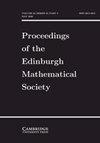论四元基本数值范围的凸性
IF 0.9
3区 数学
Q2 MATHEMATICS
Proceedings of the Edinburgh Mathematical Society
Pub Date : 2024-05-15
DOI:10.1017/s0013091524000336
引用次数: 0
摘要
一般来说,四元数环境中的数值范围是四元数的一个非凸子集。本质数值范围是数值范围的细化,只保留在某种意义上具有无限倍性的元素。我们证明了四元数希尔伯特空间上有界线性算子的基本数值范围是凸的。我们还提供了兰卡斯特定理的四元数类似定理,它涉及数值范围的闭合及其基本数值范围。本文章由计算机程序翻译,如有差异,请以英文原文为准。
On the convexity of the quaternionic essential numerical range
The numerical range in the quaternionic setting is, in general, a non-convex subset of the quaternions. The essential numerical range is a refinement of the numerical range that only keeps the elements that have, in a certain sense, infinite multiplicity. We prove that the essential numerical range of a bounded linear operator on a quaternionic Hilbert space is convex. A quaternionic analogue of Lancaster theorem, relating the closure of the numerical range and its essential numerical range, is also provided.
求助全文
通过发布文献求助,成功后即可免费获取论文全文。
去求助
来源期刊
CiteScore
1.10
自引率
0.00%
发文量
49
审稿时长
6 months
期刊介绍:
The Edinburgh Mathematical Society was founded in 1883 and over the years, has evolved into the principal society for the promotion of mathematics research in Scotland. The Society has published its Proceedings since 1884. This journal contains research papers on topics in a broad range of pure and applied mathematics, together with a number of topical book reviews.

 求助内容:
求助内容: 应助结果提醒方式:
应助结果提醒方式:


